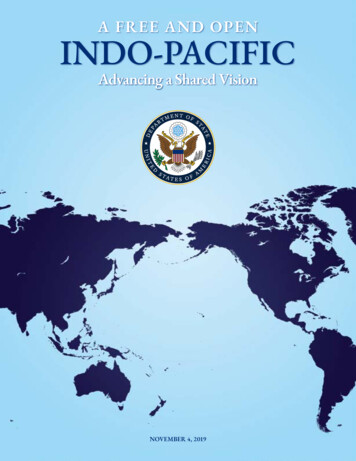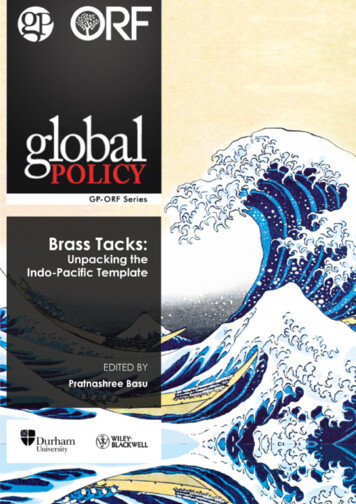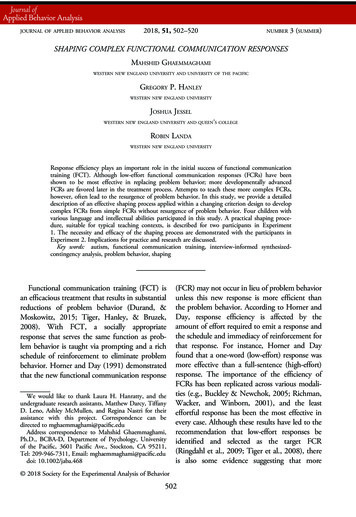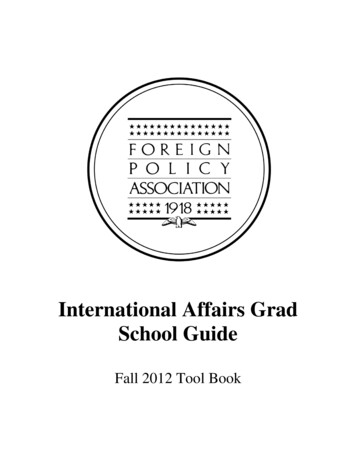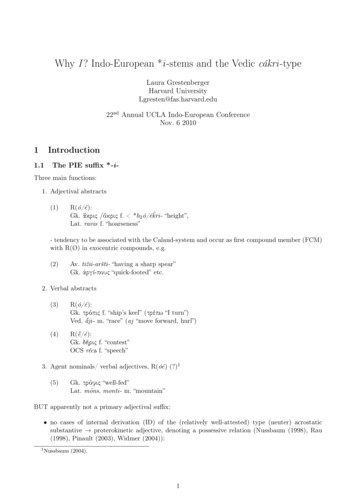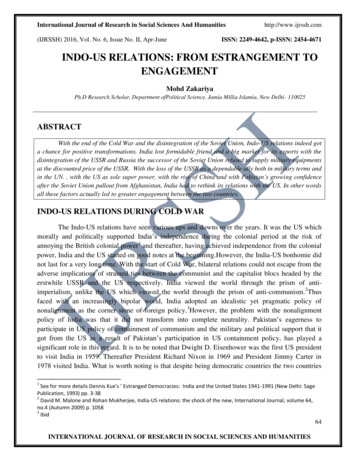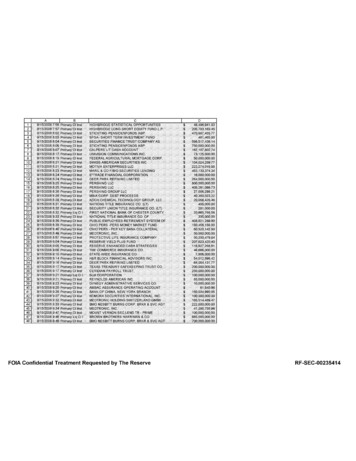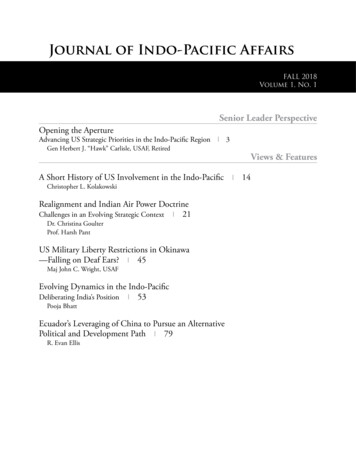
Transcription
Journal of Indo-Pacific AffairsFALL 2018Volume 1, No. 1Senior Leader PerspectiveOpening the ApertureAdvancing US Strategic Priorities in the Indo-Pacific RegionGen Herbert J. “Hawk” Carlisle, USAF, Retired 3A Short History of US Involvement in the Indo-Pacific 14Christopher L. KolakowskiRealignment and Indian Air Power DoctrineChallenges in an Evolving Strategic Context 21Dr. Christina GoulterProf. Harsh PantUS Military Liberty Restrictions in Okinawa—Falling on Deaf Ears? 45Maj John C. Wright, USAFEvolving Dynamics in the Indo-PacificDeliberating India’s Position 53Pooja BhattEcuador’s Leveraging of China to Pursue an AlternativePolitical and Development Path 79R. Evan EllisViews & Features
Editorial AdvisorsDr. Ernest Allan Rockwell, Director, Air University PressGen Herbert J. “Hawk” Carlisle, USAF, Retired; President and CEO, National Defense Industrial AssociationDr. Matthew C. Stafford, Chief Academic Officer, Air Education and Training CommandCol Jeff Donnithorne, USAF, PhD, Chief Academic Officer, Air UniversityReviewersGp Capt Nasim AbbasInstructor, Air War CollegePakistan Air ForceDr. Jessica JordanAssistant Professor, Air Force Culture and Language CenterAir UniversityDr. Sascha-Dominik “Dov” BachmannAssoc. Prof. & Director, Centre ofConflict, Rule of Law and SocietyBournemouth University (United Kingdom)Mr. Chris KolakowskiDirectorThe General Douglas MacArthur MemorialDr. Lewis BernsteinHistorian, retiredUnited States ArmyDr. Paul J. BoltProfessor, Political ScienceUS Air Force AcademyCDR John F. Bradford, USNPresidentYokosuka Council on Asia–Pacific StudiesDr. Stephen F. BurgessProfessor, Air War CollegeAir UniversityDr. Chester B. CabalzaVice President, Center of Research and Strategic StudiesDevelopment Academy of the PhilippinesMr. Eric ChanPolicy AnalystUnited States Air ForceDr. Adam ClaasenSenior Lecturer in HistoryMassey University (New Zealand)Dr. Carlo KoppLecturerMonash University (Australia)Lt Col Scott D. McDonald, USMCMilitary ProfessorDaniel K. Inouye Asia–Pacific Center for Security StudiesDr. Brendan S. MulvaneyDirector, China Aerospace Studies InstituteAir UniversityDr. Satoru NagaoVisiting FellowHudson InstituteDr. James E. PlatteAssistant Professor, Center for Unconventional Weapons StudiesAir UniversityDr. Jim RolfeSenior Fellow, Centre for Strategic StudiesVictoria University of Wellington (New Zealand)Mr. Richard M. RossowSenior Adviser and Wadhwani Chair in US–India Policy StudiesCenter for Strategic and International StudiesCDR Mark R. CondenoPhilippine Coast GuardMaj Gary J. Sampson, USMCForeign Area Officer, Northeast AsiaPhD Student, Fletcher School, Tufts UniversityDr. Zack CooperSenior Fellow for Asian SecurityCenter for Strategic and International StudiesCommodore Abhay Kumar Singh, retiredResearch FellowInstitute for Defence Studies and Analyses (India)Dr. Ian C. ForsythLead Intelligence AnalystFulcrum, LLCDr. Bawa SinghAssistant Professor, Global RelationsCentral University of Punjab (India)Dr. Jai GalliottDefense Analyst, Cyber SecurityAustralian Defence Force AcademyMr. Daniel K. TaylorSenior Defense Intelligence Analyst for ChinaAsia–Pacific Regional Center, Defense Intelligence AgencyMaj Jessica GottStrategy OfficerHeadquarters, USAFDr. Lavanya VemsaniProfessor, History and Religious StudiesShawnee State UniversityDr. Achala Gunasekara-RockwellIndian Languages and Cultural AdvisorUniversity of Alabama at BirminghamMr. Keith WebsterSenior Vice President for Defense and AerospaceUS–India Strategic Partnership ForumDr. Akhlaque HaqueProfessor of Political Science and Public AdministrationUniversity of Alabama at BirminghamBrig Gen Craig D. Wills, USAFDirector of Strategy, Plans, and ProgramsPacific Air ForcesDr. Manabrata GuhaDistinguished Fellow, Centre for Joint Warfare StudiesMinistry of Defence (India)Dr. Roland B. WilsonProgram Coordinator & Professor of Conflict Analysis& ResolutionGeorge Mason University, Korea CampusDr. B. M. JainProfessor, Political Science and International RelationsEditor-in-Chief, Indian Journal of Asian AffairsFall 2018 2
Senior Leader PerspectiveOpening the ApertureAdvancing US Strategic Priorities in the Indo-Pacific RegionGen Herbert J. “Hawk” Carlisle, USAF, RetiredNo doubt, North Korea puts on a great fireworks display. Yet, while Americans fixated on the volatile dictator rattling rockets on the Korean Peninsula, the rest of the Indo-Pacific region continued to transform at an increasinglybreakneck pace. Public discourse on US defense strategy in Asia is outdated, reflecting a fixation on legacy threats, disputes, and commitments of the last centuryrather than the emerging threats and opportunities of this century. The renamingof US Pacific Command to US Indo-Pacific Command (USINDOPACOM) provides the United States with an opportunity to expand the aperture of US grandstrategy and to engage the region clear eyed. While the regional security map ofthe twentieth century prioritized Northeast Asia, the map of the twenty-first century demands strategic attention spotlight a wider landscape characterized by People’s Republic of China’s (PRC) hegemonic aspirations and a larger set of competing national interests. As the United States learns to look at Asian security throughan Indo-Pacific lens, securing the American commitment to a free and open IndoPacific will require focused attention on three issues: (1) denying the PRC’s assertion of control of the South China Sea, (2) leveraging Indo-Pacific economic integration to balance against Chinese economic power, and (3) integrating India as aregional security partner.To understand the worrisome gaps in the national discussion of US defensestrategy in the Indo-Pacific region, consider the simple difference between the media attention devoted to North Korea’s recent provocations against the UnitedStates and its allies and the attention directed to the PRC’s aggressive actions inthe South China Sea. North Korea and the PRC both engaged in a series of provocative military actions throughout 2017. Between Inauguration Day 2017 andNew Year’s Eve 2017, The New York Times, the daily foreign affairs news source ofchoice for Washington policy elites, published 1,179 articles containing the words“North Korea nuclear” versus 377 articles containing the words “South ChinaSea.” When on 9 August 2017, North Korea announced its intent to fire four test missiles close to the US territory of Guam, The New York Times published 91 articles containing “North Korea nuclear” during the following week. When on 10 August 2017,Chinese naval vessels confronted US naval ships conducting freedom-of-navigation patrols in the South China Sea, the next week saw The New York Times publish a mere 8Fall 2018 3
articles containing “South China Sea.” By these measures, hostile military contact between the world’s most consequential powers was less newsworthy than the test launchof 1960s rocket technology.What made this discrepancy puzzling is that there is no particular reason to believe the North Korea situation warranted such a large prioritization in coverageover the South China Sea disputes. Fear of war between the United States andNorth Korea is justified but remains unlikely, especially taken in context of NorthKorea’s history of hundreds of provocations against the United States and its alliesin Northeast Asia since the end of the Korean War. Meanwhile, the PRC’s unprecedented aggressive territorial control measures in the South China Sea repeatedlybrought opposing military forces into close contact. Strategically, the attention theUnited States pays to North Korean tensions must be balanced with the need totake effective action to counter the PRC in the South China Sea.Enduring Twentieth-Century Legacyon US Indo-Pacific Grand StrategyOne reason North Korea receives disproportionate attention in the public discourse on US defense strategy in the Indo-Pacific is because policy makers failed toevolve twentieth-century notions of US security interests in the region in conjunction with the changing strategic landscape. Post-World War II, US strategic objectives in the Indo-Pacific included protecting allies, containing authoritarian communism, maintaining regional stability, and supporting free trade. As thedominant military power in the Indo-Pacific, the United States guaranteed securityfor its allies by permanently forward basing forces in Japan, the Republic of Korea,and the Philippines and conducting regular exercises with other allies in the region. The United States also offered security guarantees to Taiwan to help maintainits independence from the PRC. The large US security umbrella in the Indo-Pacific helped to deter communist expansion, and, by assuring allies of their protection, helped to demilitarize and stabilize the region. The United States supplemented its military presence in the Indo-Pacific with economic and diplomaticpower, developing trade and political relationships often leveraged to promote liberal economic institutions and to encourage anti-communist resistance. US economic and security guarantees created conditions for non-aligned nations to coexist peacefully as well. This effective strategy built the foundation for peace and4 Journal of Indo-Pacific Affairs
Senior Leader Perspectiveeconomic success for many, if not most, Indo-Pacific nations through the end ofthe twentieth century.The changing political structures and socio-economic landscape of the regiondid little to change US Indo-Pacific regional security strategy. The basing and posture of US forces in the Indo-Pacific continue to prioritize the deterrence and assurance needs of US allies in the northeast. When the fall of the Soviet Union andthe rocky détente between the United States and the PRC reduced the overallthreat to allies and interests in the Indo-Pacific, the United States retained focus onthe communist regimes of North Korea and mainland China. The general peaceand prosperity of Indo-Pacific during the post-Cold War era enabled the UnitedStates to rely heavily on economic and diplomatic engagement to achieve its interests in the rest of the region.The PRC’s post–Cold War growth disrupted the old security order in the IndoPacific, in no small measure by selectively flouting and exploiting internationalrules. China’s turn from impoverished communism to an increasingly prosperousstate-managed capitalism enabled its rise from ranking 11th in gross domesticproduct (GDP) among nations in 1980 to second in 2017, transforming it into aglobal power. Following an import substitution strategy built on cheap labor copying and manufacturing foreign innovations, the PRC reinvested the earnings fromits export-driven economic growth to enhance its economic, diplomatic, and military power. China now challenges the United States as the Indo-Pacific’s dominantinfluence on regional affairs. While the PRC’s power grows, American influence inthe Indo-Pacific declines, straining under the weight of America’s commitments inthe Middle East and throughout the world. According to the World Bank, Chinaand the United States are now roughly equal as destinations for Indo-Pacific exports; however, China exports double the amount of goods and services to otherIndo-Pacific countries. China has seven free trade agreements with Indo-Pacificpartners, under implementation or signed, while the United States has three. Finally, despite China’s heavy investments in expanding and modernizing its armedforces, US military deployments to the Indo-Pacific region have roughly stayed thesame for the last two decades.Opening the Aperture of US Grand Strategy in the Indo-PacificThis challenge from China calls for the United States to “open the aperture” ofits grand strategy. Doing so will allow the United States to get a much bigger picture and better understanding of the entire region. The big picture in the Indo-PaFall 2018 5
cific region shows current US engagement—economic, diplomatic, and military—is insufficient to secure American objectives against China’s hegemonic push forregional power.Department of Defense (DOD) leaders show strong signs of recognizing howthe United States must respond to this challenge. In May 2018, the DOD renamed US Pacific Command (USPACOM) as US Indo-Pacific Command(USINDOPACOM). At a ceremony announcing the change, Secretary of DefenseJames Mattis remarked that the name change recognized the importance of America’s allies and relationships with countries bordering the Indian Ocean as well asthe Pacific Ocean to maintaining regional stability and achieving a shared vision ofan Indo-Pacific region of “many belts and many roads,” countering the PRC’s OneBelt, One Road Initiative.Opening the aperture of US Indo-Pacific grand strategy requires more than aname change. It also requires changes to America’s strategic priorities. If, as the2018 National Defense Strategy declares, the United States has entered an “era ofgreat power competition,” then the United States should engage in a full-spectrum, whole-of-government competition against the PRC’s ambitions for IndoPacific dominance. Too often, US strategic priorities in the Indo-Pacific regionseem narrowly constructed around the specific geography of Northeast Asia andaround traditional military and diplomatic solutions. The big picture of the IndoPacific balance of power strongly suggests that America’s most important prioritiesencompass the region’s full geography and have solutions that include, but certainly are not limited to, traditional military and diplomatic approaches. As mentioned earlier, three issues stand-out as most deserving of immediate prioritization:(1) control of the South China Sea; (2) enhanced US economic integration in theIndo-Pacific; and (3) the US–India regional security partnership.Control of the South China SeaDisputes over control of the South China Sea are a simmering crisis of regionaland global importance. Since 2009, China has unilaterally, and without international legal support, claimed sovereign rights over most of the South China Sea,invoking the 1947 “nine-dash line” boundary and recently increasing the claim tothe “ten-dashed line,” placing at risk the core American interest of free and opennavigation of Indo-Pacific waters. The PRC’s militarized campaign of land reclamation, involving hundreds of islands and atolls in the South China Sea, is also6 Journal of Indo-Pacific Affairs
Senior Leader Perspectivetriggering multiple disputes between China and its Southeast Asian neighbors, inparticular, Vietnam and the Philippines.Many of the disputes center on the Spratly Islands, the largest of the SouthChina Sea’s island groups. The Spratly’s scattered geography and shallow watersonce made them dangerous territory for ships, but British and American navalmapping of sea lanes allowed the South China Sea to evolve into a major international transshipment corridor. A nation with control of the Spratly’s sea lanescould strangle international commerce. Through a series of invasive military measures, China positioned itself to gain such control. For example, in 2014, it prevented the Philippines from resupplying a detachment of their marines based inthe southern zone of the Spratly. Thus, the PRC has demonstrated the capability,capacity, and will to execute naval blockade operations through a key maritimechokepoint.Preventing China from impeding shipping in the Spratly should be amongAmerica’s top strategic priorities because that strategic line of communication enables global commerce. The South China Sea has become a vital hub of the globaleconomy. Huge growth in global trade volumes with China and Southeast Asiahave driven a corresponding surge in the shipping volumes that pass through theSouth China Sea. Nearly half of all global oil tanker traffic passes through theSouth China Sea (five times greater than the volume of traffic passing through thePanama Canal). Several of the world’s largest shipping ports are located close tothe South China Sea. Although the PRC is unlikely to disrupt freedom of navigation casually, because it normally benefits from it, during a future regional conflict,its control of an important economic chokepoint would provide a significant strategic advantage. However, shipping is not the only economic priority in the SouthChina Sea.A free and open South China Sea is also important to all Southeast Asia nationsbecause of the potential economic benefits from the region’s natural resources. TheSouth China Sea provides a rich source of fossil energy resources and fisheries.Competition for these resources has driven multiple disputes in the region. For instance, Chinese oil companies have competed with a joint Vietnamese–Indianproject to develop oil and gas resources in the South China Sea. Most recently, in2014 Chinese security ships used water cannons to deter a Vietnamese flotilla thattried to sail into Chinese oil drilling claims in the Paracel Islands. Additionally, adecline of fisheries’ production in the South China Sea has led to territorial disputes, such as the 2012 crisis that ensued after the Philippine Navy detained eightFall 2018 7
Chinese fishing craft in the Scarborough Shoal. The PRC appears willing and ableto use its military and economic strength to ensure it controls a disproportionateshare of the natural resources in the South China Sea.As a part of an Indo-Pacific grand strategy, the United States must develop policies and capabilities to deter and, if necessary, overcome Chinese actions to controlthe South China Sea. The United States should continue to prioritize freedom ofnavigation for all nations and create conditions for regional and international forums to determine resource allocation. The PRC’s current forces in the SouthChina Sea are increasingly formidable. Incoming USINDOPACOM commanderAdm Philip Davidson stated China is now capable of “overwhelming” any otherisland claimants in the South China Sea and is capable of controlling access to anduse of the shipping lanes. To effectively counter Chinese forces, the United Stateswill need to prioritize a permanent and rotating military presence in the region.Only by presenting a credible military deterrent will US leaders be able to insist onfreedom of navigation and independent adjudication of Chinese territorial claims.US Navy Adm Philip S. Davidson, left, shakes hands with Navy Adm Harry B. Harris during the change-of-commandceremony in which Davidson assumed command of US Indo-Pacific Command at Joint Base Pearl Harbor-Hickam, Hawaii,30 May 2018. Air Force photo by Airman 1st Class Nathan H. Barbour.8 Journal of Indo-Pacific Affairs
Senior Leader PerspectiveEODMU 5, Australian and US forces train together on Guam. Explosive Ordnance Disposal Technician 3rd ClassDevin Rodriquez, right, looks on as Senior Chief Explosive Ordnance Disposal Technician Luigi Mendoza, center, andan Australian Army soldier coordinate during the unit-level training event Pyrocrab. Held biennially, Pyrocrab focuseson strengthening relationships and enhancing interoperability between the US Navy and Australian forces. EODMU-5is assigned to commander, Task Force 75, the primary expeditionary task force responsible for the planning andexecution of coastal riverine operations, explosive ordnance disposal, diving engineering and construction, andunderwater construction in the US 7th Fleet area of operations. US Navy Photo by Mass Communication Specialist3rd Class Kryzentia Richards.The United States must also harness the power of alliances and partnerships to enlist participation in regional cooperative security arrangements that help to counterChinese forces. US naval forces regularly conduct freedom of navigation operations(FONOPS), essentially sea patrols through disputed waters, in the South China Sea,to “exercise and assert [US] navigation and overflight rights and freedoms on aworldwide basis in a manner that is consistent with the balance of interests reflectedin the Law of the Sea (LOS) Convention.” The United States works with traditionalnaval allies such as Japan, Australia, the United Kingdom, and France in FONOPSbut needs to increase the involvement of Association of Southeast Asian Nations(ASEAN) countries in these patrols to enhance the scale and consistency of such operations. Another example of the kind of cooperative engagement that will play animportant role in the Indo-Pacific is the Quadrilateral Security Dialogue, also knownas “the Quad.” Reconvened in November 2017 after a 10-year hiatus, the Quad is aninformal gathering of defense officials from the United States, Japan, Australia, andIndia to discuss Indo-Pacific security issues.Fall 2018 9
Trade Partnerships & the Role of Economic Integration in the Indo-PacificTrade relationships are strategically important for maintaining a free and openIndo-Pacific region. Once an afterthought, the economies of Southeast Asia areamong the world’s fastest-growing and are important to global production networks.However, the massive Chinese economy increasingly dominates regional trade andcapital flows. As a result, many of the region’s economies are increasingly connectedto the Chinese economy and, therefore, sensitive to Chinese policy preferences.These countries are increasingly pulled into China’s economic and political orbit, becoming outlets for Chinese goods, services, capital, and policies. They could providethe PRC with important diplomatic and military backing for its regional hegemonicgoals.The United States should counteract Chinese economic and political influence bydeveloping trade partnerships with Southeast Asian economies. Trade partnershipsalso help improve US economic competitiveness against China. Negotiated tradeagreements can help to improve conditions under which a country’s corporationsconduct business, by reducing barriers to market access, affirming intellectual property rights, and equalizing labor and environmental standards. Without such agreements in place, US companies may operate at a disadvantage in comparison withnative competitors or competitors from countries with their own trade agreements.The controversy over the multilateral Trans-Pacific Partnership (TPP) trade agreement should not dissuade US policy makers from negotiating future trade partnerships in Southeast Asia and other parts of the Indo-Pacific. In fact, America’s withdrawal from the TPP should do the opposite. The TPP attempted to establish anencompassing trade regime linking key economies of Southeast Asia and Oceaniawith the North American free trade zone. Some in the United States criticized theTPP for potentially weakening domestic investment by US companies and creatinganother back door for Chinese products to flood the American market. These potential pitfalls cannot be overlooked. However, many economic and foreign affairsexperts extolled the TPP benefits as necessary to ensure the long-term competitiveness of US companies operating in the Indo-Pacific, and as an important tool forbuilding support for economic liberalism. By pulling out of TPP, the United Stateslost an opportunity to lead the region economically, while simultaneously missingan opportunity to provide a viable alternative to a China-centric regional economicsystem. Despite the US withdrawal, the other 11 participant countries, comprising10 Journal of Indo-Pacific Affairs
Senior Leader Perspectivenearly 16 percent of worldwide economic production, renegotiated and authorizedthe agreement as the Comprehensive and Progressive Agreement for Trans-PacificPartnership. Notwithstanding any merits of withdrawing from the negotiations,the United States’ absence sacrificed an opportunity to strengthen its regional partnerships outside of defense relationships. It also limited economic interdependencebetween the United States and those nations, weakening the potential foundationof a transformational whole-of-government US strategy for the region. Finally, itprovided China an opening to raise the profile of its own multilateral regionaltrade partnership strategy. The United States must work diligently to build economic and trade cooperation with the nations of the Indo-Pacific.India and the Indo-Pacific’s Future Balance of PowerSkepticism of US reliability and intensions in the region may damage America’srelationship with the nation whose impact in the region will only increase over thenext decade. The bulk of the DOD’s justification for renaming USINDOPACOMrecognized the deep linkages between India and the future of Pacific Rim affairs.India’s integration into regional economic and security partnerships has the potential to dramatically shift the balance of power in the Indo-Pacific region. Expectedto become the world’s most populous country by 2024 and currently the world’ssixth largest economy, India exemplifies the traits of a rising global economic andmilitary power. India’s economy is strongly interdependent with the rest of theIndo-Pacific, exporting nearly 23 percent of the goods imported into East Asianand Pacific countries, while importing over 38 percent of the goods exported bythose countries. Home to one of the world’s largest armed forces and defense budgets, India is expanding its military, announcing in February 2018 plans to increase defense spending by nearly 8 percent for the 2018–2019 fiscal year.For the United States, India is attractive as a potential security ally and tradingpartner. Not only does India have the world’s second-largest military, it is also oneof the relatively few nations that possesses an aircraft carrier, giving it the ability toproject military power at regional distances and scales. In recognition of its strategicimportance, in 2016 the United States conferred “Major Defense Partner” status onIndia. Although India has a post-colonial tradition of neutrality between competing great powers, its current political leadership has expressed interest in participating in regional cooperative security ventures.The United States and India share a strategic imperative to hedge against Chinese regional dominance. India fought a minor war against China in 1962, and itsFall 2018 11
subsequent relationship with China has been tense. For example, China blockedIndia’s ambitions to join the UN Security Council, and India has resisted China’sOne Belt, One Road Initiative. More recently, Chinese and Indian armed forcesengaged in a months-long standoff in 2017, triggered by Chinese road-building inthe Bhutanese territory of Doklam near the Chinese-Indian Border. Most troublesome for India, China forged a security partnership with Pakistan, India’s bitter rival, even announcing in late 2017 plans to construct a strategic offshore naval basein Pakistan. Therefore, the current relationship between the countries is characterized by deep suspicion and conflict. Through more intensive engagement with India, the United States might forge a partnership that could transform grand strategy in the region.ConclusionThe United States can no longer afford to have a grand strategy for the Indo-Pacific based primarily on legacy defense priorities and commitments. To be sure,traditional issues such as the defense of Japan, South Korea, and Taiwan are andwill remain important areas of strategic interest. However, in a rapidly evolvingAsian economic, political, and security landscape, the United States must widen itsstrategic aperture to recognize and respond to changing regional dynamics. The renaming of US Pacific Command as US Indo-Pacific Command begins to implement strategic changes necessary if the United States intends to achieve its visionof “free and open” access to the Asian markets. The United States must open theaperture of its strategy in Asia to recognize and engage other, lesser known, butstrategically important issues. Maintaining a free and open Indo-Pacific regionagainst an increasingly powerful China will require a combination of deterrenceand assurance measures. As the PRC tries to assert control over the South ChinaSea, the United States must invest in the capabilities and capacity sufficient to deter aggression. Developing more and better trade partnerships with the emergingeconomies of the Indo-Pacific is an important step in limiting the PRC’s economicand diplomatic influence. Finally, developing a robust partnership with India canhelp counter Chinese hegemonic aspirations by fundamentally altering the region’sbalance of power. JIPANotes1. James N. Mattis, “Remarks at U.S. Indo-Pacific Change of Command Ceremony” (speech transcript, US Department of Defense, 30 May 2018), command-change-of-command-ceremony/. The One Belt, One Road Initiative is a push bythe PRC to take a more prominent role in global affairs through the establishment of a China-centric trading network.12 Journal of Indo-Pacific Affairs
Senior Leader Perspective2. US Department of State, “Maritime Security and Navigation,” website, n.d., ity/.3. Ankit Panda, “US Implementation of ‘Major Defense Partner’ Perks for India Underway,” Diplomat (website), 14April 2017, Herbert J. “Hawk” CarlisleGen Herbert J. “Hawk” Carlisle, USAF, retired, is president and chiefexecutive officer of the National Defense Industrial Association. GeneralCarlisle came to NDIA after a 39-year career in the Air Force, from whichhe retired as a four-star general in March 2017. His last assignment was ascommander, Air Combat Command at Langley Air Force Base in Virginia.Before that, Carlisle was the commander of Pacific Air Forces; the air component commander for US Pacific Command; and executive director ofPacific Air Combat Operations staff, Joint Base Pearl Harbor, Hawaii.Carlisle serve
R. Evan Ellis FALL 2018 Volume 1, No. 1 Journal of Indo-Pacific Affairs. Fall 2 Gp Capt Nasim Abbas . Ministry of Defence (India) Dr. B. M. Jain Professor, Political Science and International Relations . Mr. Keith Webster Senior Vice President for Defense and Aerospace
